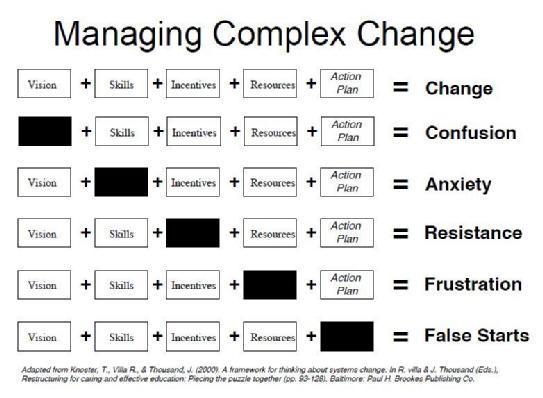Take a look at the graphic above. Your goal is change. Every organization needs to change sometimes — business plans adjust, revenue streams change, leadership turns over, etc. So if your goal is change, how do you achieve that?
Here are the key factors:
- Vision
- Skills
- Incentives
- Resources
- Action Plan
Let’s take this one by one.
Vision: This one is tough for a lot of people. First off, it’s a fluffy word. It means something different to 100 different people you might ask about it. Second off, there’s a major problem with using “vision” in a work construct — namely, senior leaders tend to only meet with each other as they “craft vision,” and then the vision is pushed down the chain. Without full-scale buy-in, vision means nothing. Phrased another way: you can ‘craft vision’ all you want, but you need to listen to people about their feedback on said vision. Most people forget that step. That’s kind of the same problem with establishing some type of “purpose” at work. When you lack the vision part of this five-factor model, you create confusion for people throughout the organization.
Skills: This basically just means “having the right people in the right slots.” Again, this is fraught for a lot of organizations — our hiring methods are ridiculously outdated relative to the information we have about people and performance, and everyone rushes to get new people and doesn’t really think about the ‘headcount’ process. This creates unclear, overlapping job roles. That’s bad. When you lack the skills part of this five-factor model, you create anxiety for people throughout the organization.
Incentives: This one is fraught too. (What isn’t?) The problem is that most people think “incentives” means “perks and salary,” when in fact it mostly means “working with and for people who respect you.” There needs to be some incentive to do the work and make the change, though — and often the biggest such incentive is understanding the why, or the underlying purpose, of the change. Organizations often change horses mid-stream and no one down the line knows why, so the assumption is “Oh, we probably need to make more money.” That’s great and maybe it means a better bonus for you that year, but … it probably means a better bonus for your boss and more unclear deliverables for you. When you lack the incentives part of this five-factor model, you create resistance throughout the organization.
Resources: This goes back to people and having them in the right places, but it also speaks to process and protocol and just having what you need to achieve a goal or make a change. That could mean a functioning copier, it could mean personnel, or it could mean a bunch of consultants coming in. (Although hopefully it doesn’t mean that.) When you lack the resources part of this five-factor model, you create frustration throughout the organization.
Action Plan: This works the same way as a meeting; you can’t leave a meeting without an action plan, and you can’t attempt to start a change process without one either. This part kind of goes to something I mentioned above, though — an “action plan” doesn’t mean the senior leaders talking together and then throwing a plan down the chain. There’s no engagement in that model. Even if you have a totally “monkey see, monkey do” organization, the action plan will fall apart without some semblance of buy-in. If you lack the action plan part of this five-factor model, you create false starts throughout the organization.
I sometimes think work would be a lot simpler if we just had a few mandatory “stop and think” periods on every new initiative — especially change processes — instead of just rushing from e-mail to meeting and back again. Yes?

Reblogged this on Gr8fullsoul.
A change in vision is like choosing a new flight plan. “We were going to go here, and now we’re going there.” Maybe some people won’t/don’t care. But most will.
Mandatory “slow down and think” sessions should be a regular ritualized occurrence.